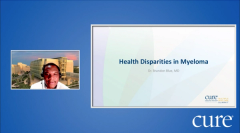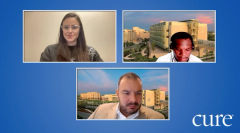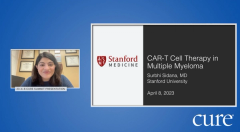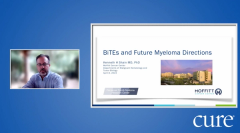
Educated Patient® Multiple Myeloma Summit BiTE and Future Myeloma Directions Presentation: April 8, 2023
Watch Dr. Kenneth H. Shain, from Moffitt Cancer Center, discuss the future of myeloma treatment, including BiTE therapy, during the CURE Educated Patient Multiple Myeloma Summit.
Episodes in this series

As treatment for multiple myeloma continues to become more personalized for each individual patient, bispecific T-cell engagers — known as BiTE therapies — offer yet another option for patients with relapsed or refractory disease and may be more accessible than CAR-T cell therapy, explained Dr. Kenneth H. Shain.
Shain, who is an associate member of the Department of Malignant Hematology and Tumor Biology at the Moffitt Cancer Center in Tampa, Florida, recently discussed BiTE therapies and future myeloma directions at the CURE® Educated Patient® Multiple Myeloma Summit.
Bispecific antibodies work by targeting both BCMA — an antigen expressed on myeloma cells — and T cells, which are a part of the immune system. While both BiTE and CAR-T cell therapy involve using T cells to fight cancer, CAR-T cell therapy involves harvesting a patient’s T cells, engineering them to find and fight cancer and infusing them back into the patient — a process that typically takes a couple of weeks.
“Instead of having to produce new T cells, it uses the T cells that are in you, and then brings them to the myeloma cells to kill them directly, finding a bridge and overcoming that resistance to the immune system,” Shain said.
However, while patients on BiTE therapy get to avoid the T-cell harvesting and manufacturing process, those undergoing this type of therapy still require hospitalization.
“Hopefully we can start learning how to (administer this drug) (in the) outpatient (setting),” Shain said. “And, all of the non-hospitalized stuff can be done locally, but you have to have more buy-in from local physicians.”
The first BiTE drug approved in the myeloma space was
Additionally, research is currently underway examining Tecvayli, as well as three other BCMA-targeted BiTE drugs for myeloma: elranatamab, linvoseltamab and TNB-383B; plus two other direct T-cell engagers that target something other than BCMA (talquetamab and cevostamab).
Since BiTE therapies use the immune system to fight cancer, there are immune-related side effects that patients need to be on the lookout for, Shain explained, noting that some side effects are acute (happen short-term), such as cytokine release storm.
“That’s (when) you have massive inflammation (from) the release of cytokines, which is what happens when you are super sick — you get fevers and chills,” he said. “We’re inducing that same process and your immune system is going to (release inflammatory cytokines).”
More long-term side effects can include neurotoxicity and prolonged cytopenia (decrease in red blood cells).
“This is a new set of toxicities that we’re all learning how to help mitigate so we can maintain patients on these therapies,” Shain said. “Low blood counts are normal; we know how to take care of cytopenias, but here we’re talking about more prolonged cytopenia.”
Additionally, Shain said that patients on other BiTE therapies may experience an increased risk of infection, as well as rashes, nail issues, loss of taste and other side effects — all of which should be brought up to the health care team to ensure that patients can remain on therapy.
“These are very powerful therapies, and we want to make sure that patients can stay on these therapies and that they work for them for a long time,” Shain said.
For more news on cancer updates, research and education, don’t forget to













